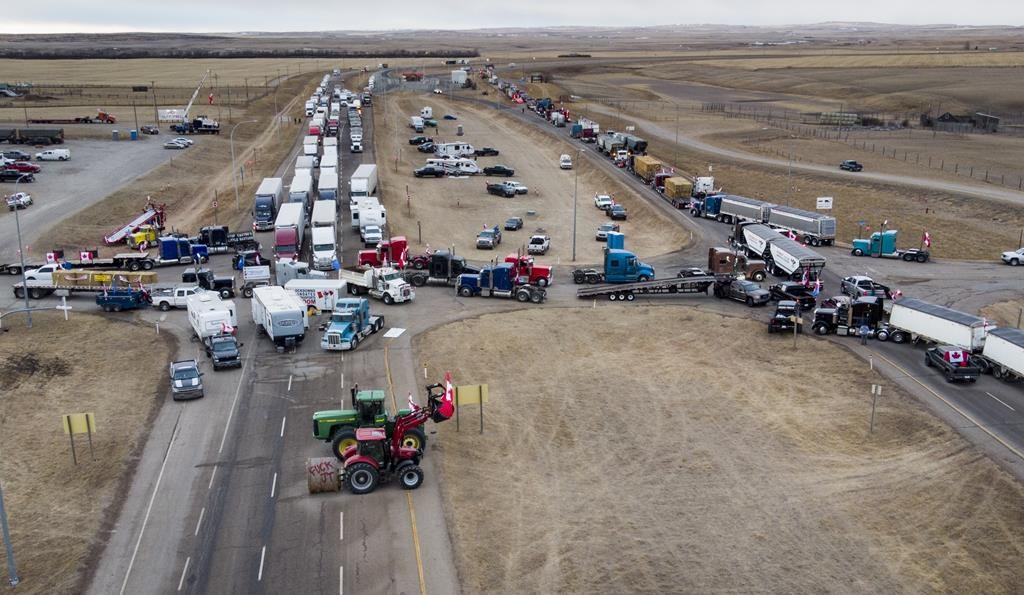RCMP appeared caught off guard by protesters blockading a Canada-U.S. border crossing last winter despite Alberta’s government being warned ahead of time, the mayor of Coutts, Alta., testified at a public inquiry Wednesday.

Mayor Jim Willett said he spotted a social media post about plans for the blockade and notified provincial officials two days before a convoy of trucks appeared in the town.
Willett was appearing before the Public Order Emergency Commission, which is investigating the federal Liberals’ use of the Emergencies Act weeks into the “Freedom Convoy” protests that gripped Ottawa’s downtown and inspired similar demonstrations elsewhere.
He told the inquiry that he warned Jason Kenney, the then-premier of Alberta, and the province’s solicitor general about the impending protest by email on Jan. 27.
Coutts is a small border town of just 245 people. Willett said he worried about residents’ vital access to the highway. He also flagged the possibility of a protest turning into an international incident, he said.
The next day, the solicitor general’s office assured him the RCMP was on top of it and they had it under control.
But on Jan. 29, a large convoy of trucks appeared at the border. And just as it appeared they would take a U-turn and leave, several trucks moved to block the road.
It looked to him like the RCMP were caught off guard, he said.
“When the trucks drove into the median and across both lanes of traffic going both directions, it became obvious that nobody was in control,” he told the commission.
RCMP didn’t establish a large police presence until three days later, Willett said.
During the demonstration, hundreds of semi-trailers blocked the lanes in and out of the U.S., preventing a steady stream of commerce between the two countries.
Many of the protesters were combative. Some got into verbal confrontations with police officers, and others used farm equipment to break through roadblocks.

A second protest encampment sprang up 10 km from the border, which required around-the-clock surveillance by hundreds of RCMP officers and Alberta sheriffs.

Get daily National news
The protests ended on Feb. 14, the same day the federal Emergencies Act was invoked, after RCMP made several arrests, seized multiple restricted weapons and charged four men with conspiracy to commit murder.
At one point during the operation, protesters attempted to ram a police car with a large farm tractor and a semi truck.

Two days earlier, Willett had told a reporter for The Canadian Press that he was concerned about “a more extreme element” joining the protest, according to evidence tabled with the commission.
“You need to find someone in a protected position who will call these guys what they are, domestic terrorists,” Willett said in a text message.
“Won’t be me,” he added, explaining that he felt under threat from protesters.
“They are right outside my window. I would be strung up, literally.”
Willett became emotional several times Wednesday as he described the impact of the blockade on his small border community and its residents.
He said that he guesses about 70 per cent of people in the town supported the convoy, and it caused a major divide.
“We still have neighbours that won’t talk to each other because of the protest,” he said.

While some residents told the mayor they never had issues getting in and out of town as usual, even if they sometimes had drive through a field, others reported that they felt intimidated.
Willett broke down as he described an older woman who would curl up in a ball in the passengers seat when she was driven past the blockade to get to doctor’s appointments in the next town over.
On Tuesday, an Alberta town councillor who became an unofficial spokesman for the protesters during the demonstration told the commission that the murder plot had sullied the purpose of the blockade.
“The perception around Coutts, unfortunately, due to the discovery of the guns and such, has tainted what Coutts was,” Fort Macleod, Alta., councillor Marco Van Huigenbos said from the witness stand.

He said that after the weapons were discovered, it became clear that “every objective we were looking to achieve was no longer possible and that our message had been lost.”
The border crossing ultimately reopened on Feb. 15.
Witnesses at the inquiry this week are shedding light on two border blockades by protesters demonstrating against COVID-19 restrictions.
The other was a six-day protest in Windsor, Ont., on the Ambassador Bridge.
Wednesday’s second witness was Mario Di Tommaso, Ontario’s deputy solicitor general. In the early stages of examining Di Tommaso, Gabriel Poliquin, who is on a legal team representing the commission, collapsed on the floor.
Emergency responders were called to the Library and Archives Canada building in downtown Ottawa where hearings are being held, and proceedings were stopped as lawyers and spectators cleared the room.
Poliquin’s condition remains unclear. A spokesman for the commission said in an emailed statement that, out of respect for Poliquin and his family, it would share no further details about his health.
The public hearing resumed a few hours later and moved on to the testimony of Ian Freeman, an official with Ontario’s transport ministry.
The inquiry, which is a legal requirement under the Emergencies Act, is expected to continue hearings through Nov. 25.





Comments